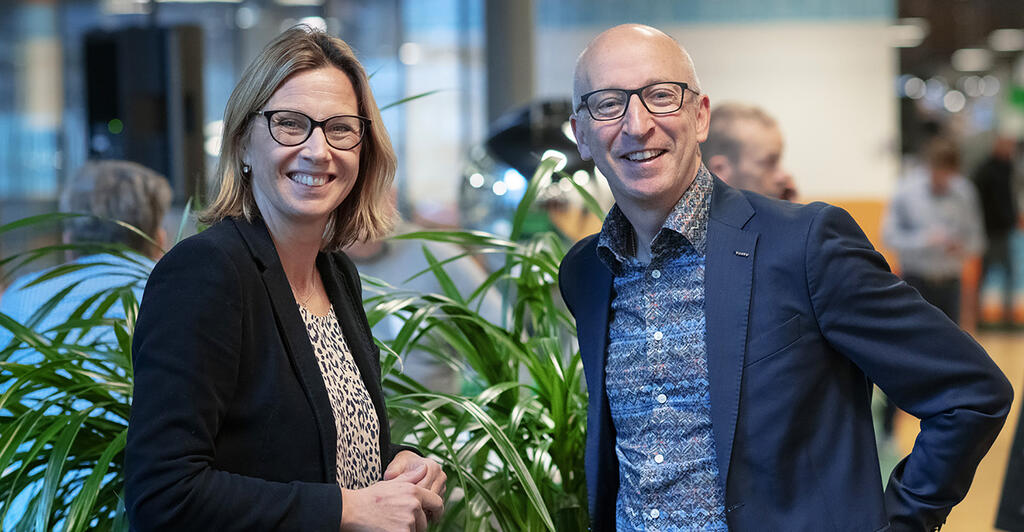This is how we should change the way we work
Tomorrow’s transport solutions – what do they look like? That question was the springboard of the talk given by Lars Stenqvist, Technical Director at the Volvo Group, at Lindholmen Connected, the recurring networking event for companies within the transport, ICT and media industries at Lindholmen Science Park.

Stenqvist focused on the three areas that form the basis for tomorrow’s transport solutions:
- Electrification
- Automation
- Internet-connected vehicles
But he also specified what it takes to develop new products:
- A new, more open way of working that creates possibilities for partners and suppliers as well as for employees.
For an audience of just over 200 at Lindholmen Open Arena, Lars Stenqvist opened by praising the environment his hosts had created:
“It’s wonderful being at Lindholmen Science Park; there’s so much innovation, openness and collaboration,” he said. “The private and public sectors are really collaborating, which is exactly what we need. And Lindholmen and Lundby together – that’s a real supercluster!”
Volvo has production in 18 countries around the world, and sales in 190. Sweden accounts for only 2% of sales – but 60% of the company’s research and development.
“Sweden is important for Volvo and Volvo is important for Sweden,” declared Stenqvist.
“Today, the transportation industry is an industry that attracts the most capital globally, and is maybe the most exciting industry,” Stenqvist said, continuing, “We firmly believe in more transportation. I know that some people have an entirely different opinion, but they’re wrong.”
Stenqvist mentioned the increasing volumes of e-commerce, where 30% of what is purchased in Europe is returned. And he pointed out that more transportation will be needed for continued global urbanization and continuing development in countries like India.
“But,” he stressed, “transportation as we know it today has a lot of downsides. We have to make it something sustainable. We’re talking about a major transition of a global transport system – with big challenges.”
The representatives Stenqvist meets around the world have high expectations of him.
“It can feel tough and unrealistic – but I think that the expectations are realistic and that we’ll be able to live up to them. It depends,” said Stenqvist, “on finding new tools in the tool box that we didn’t have a couple of years ago.”
Electrification is changing the world of transport dramatically.
Gothenburg has an electric bus line that has attracted delegates from 50 countries. Journalists ask: How much does the bus cost? The customers ask: When can we have them? The Volvo Group is overwhelmed by the reaction to the launch of its electric trucks earlier this year.
There will be development within all of Volvo’s product range: construction equipment, ship engines, etc. Electrification in Volvo’s entire product program is going faster than expected thanks to a modularized product range, with different components that can be used in different production areas.
Automation - there is already development in both the first and second steps in a five-step model.
Examples of established automation that promotes road safety include cruise control (which has been available for a long time in our cars), advanced emergency braking systems and functions that help us stay in our lane.
The higher degrees of automation include self-driving vehicles.
Very soon, there will be vehicles that can run without drivers. But this will be in safe, limited environments: mines, tunnels, quarries and so on.
Relatively soon there will also be self-driving trucks on the highways – but only on certain parts of some highways, for example in the right lane where everyone drives at the same speed, and maybe only at night.
There will never be a solution where we risk compromising road safety – it should be improved, of course.
Internet connectivity, which is both a new and an old technology.
The technology is already available in 800,000 vehicles so it would be, according to Stenqvist, slightly inaccurate to call it new. Volvo can already improve accessibility in customer vehicles by reading vehicle data and suggesting a workshop visit to prevent a truck breakdown.
But all of the data that is collected still cannot be used to its full potential.
“We are rich in data but remain poor in knowledge,” according to Stenqvist.
“Today is a great time to be an engineer,” he continued. “Development is going much faster now than before, thanks to the new technologies coming in to complement the well understood technologies we already have.”
Lars Stenqvist draws a clear conclusion:
“We have to change our way of working. We have to be more open. We have to find new ways to work with new and long-standing partners. We have to take more risks. We have to be prepared to fail more often.”
“That’s why,” explained Stenqvist, “Volvo has started conversations with suppliers, unrelated to any specific project. You ask questions: What are you working on? Do you have something exciting behind the curtain that we might not know about?”
“And you wouldn’t believe how many good conversations we’ve started through these questions and how many times they have led to us deciding to work together – when we didn’t even know what they had been doing,” said Stenqvist. “It’s about a genuine partnership.”
How do you choose who to partner with? Lars Stenqvist mentioned MobilityXLab, a collaborative project between big companies and start-ups, established a year ago at Lindholmen and where the Volvo Group is a partner. Moreover, Volvo is now setting up its own arena – CampX – at Lundby in the beginning of next year, where 500 of the company’s engineers will work with electrification and self-driving vehicles.
“But,” explained Stenqvist, “CampX will also be open for a number of external individuals. I think we have an attractive environment to offer, one of the coolest of the cool. And we’ll have start-up companies, too.”
“We’re also creating possibilities for our own employees to come up with innovative out-of-the-box ideas that we can test to see if they’ll work or not.”
On October 26, Lindholmen Connected also hosted a business exhibition that included:
Autonomous Base, ABC, which works with how self-driving vehicles can solve transport problems related to the first and last mile; shuttle buses for passenger transportation to and from work, shopping malls, campuses, the hospital, etc.
AstaZero, the leading test bed for the tomorrow’s transportation systems, with unique capacities for research, development and validation of self-driving and connected vehicles as well as the relevant infrastructure.
Carla, an initiative for ride sharing from Ericsson Garage in Gothenburg. During the summer, a team of students has worked to create a community for ride sharing as well as a user app.
MobilityXlab, an unconventional collaborative platform where global companies and small businesses with ground-breaking ideas work together to drive innovation. Partners are CEVT, Ericsson, Veoneer, Volvo Car, Volvo Group and Zenuity. MobilityXlab is hosted by Lindholmen Science Park with support from Vinnova and Region Västra Götaland.
The Volvo Group, which is continuing its substantial investment in developing the next generation of transport solutions. The latest examples are systems where autonomous vehicles are coordinated to ensure that freight transport is as efficient and safe as possible within areas characterized by short distances, large volumes and high delivery precision.

